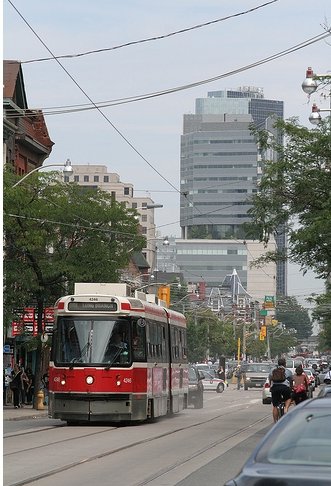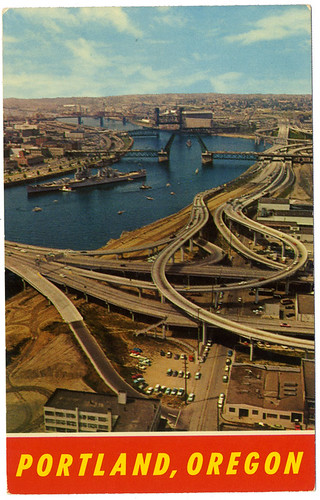Transit heights and lows

Toronto Streetcar on Queen Street West. Flickr image by Rick Heath, used by permission.
Toronto's Mayor, David Miller, has decided not to run for a third term. Nigel sends us a link to the Spacing blog, where Steve Munro writes, in "The Mayor of Transit City," about how Mayor Miller is telling the truth when he states that one of his biggest accomplishments as Mayor and before that as City Councilor, was in expanding transit.
From the article:
... Indeed, improving public transit to make Toronto a “World Class City” was part of Miller’s first, unsuccessful, bid for a Council seat in 1991. The next election, in 1994, brought Miller to the old Metro Council.
I came to know then-Councilor David Miller in his role as a Commissioner on the TTC board after the city’s amalgamation in 1998. He had a good sense of issues and advanced his positions clearly and strongly, but without grandstanding.
After the mid-1990s funding and service cutbacks, the TTC needed strong advocacy to turn it around. Ridership dropped from a 1988 high of over 463-million to a low of 372-million in 1996, creeping back over 400-million by 2000. The TTC’s only plans for service expansion were a few new subway lines, but when these would be funded and built was anyone’s guess.
Operating subsidies fell over the years, and farebox cost recovery grew from about 70% in 1988 to almost 85% by 2000. Partly this was achieved through fare increases, and partly through service cuts. This placed a greater load on riders to fund the system while quality and quantity of service declined, particularly on the surface network.
The minutes for the April 10, 2002 Commission meeting contain a small item that would fundamentally change transit planning and advocacy:
Later, the Toronto Transit Commission developed the Transit City Plan based on principles of both equity--that no one should be disadvantaged because they don't own a car--and mobility effectiveness. From the article:CC-2 Commissioner Miller submitted his communication dated April 5, 2002 to Chair Ashton with respect to the development of a ridership growth strategy.
COMMISSIONER MILLER MOVED THAT STAFF BE REQUESTED TO BEGIN DEVELOPMENT, IN CONSULTATION WITH COMMISSIONERS, OF A REPORT ON A RIDERSHIP GROWTH STRATEGY.
THE COMMISSION APPROVED COMMISSIONER MILLER’S MOTION.
Recently, the TTC published the Transit City Bus Plan (TCBP). This continues the focus on surface operations and transit’s attractiveness by proposing a core network of routes where service would always be at least every 10 minutes. This complements the subway policy headway of 5 minutes at all hours. Like its predecessor RGS, the TCBP makes incremental changes to the system to keep the cost of each change modest and to allow selective implementation of each stage. Most importantly, the TCBP looks at transit service from a network viewpoint, not as a single project of little benefit to most riders.
-- Toronto Ridership Growth Strategy.
2. This article from the Portland Mercury, "The Dead Freeway Society: The Strange History of Portland's Unbuilt Roads," discusses how great Portland, Oregon is because they ended up not building planned freeways AND THEY TORE DOWN EXISTING FREEWAYS.

Portland's waterfront used to be scarred with freeways.
Ironically, DC is no less great because most plans to build freeways within the city were also dropped, and instead, a subway _system_ was built. Interestingly, initial planning for freeways was paired with "rapid transit" planning, with plans to put rail lines in the middle of freeways.
(One of the most "accessible" articles about this topic is "END OF THE ROADS; In the Interstate Era, Congress ruled Washington like a fiefdom. Then a fight over some freeways inspired a biracial, neighborhood-level movement to fight the federal power" from the Washington Post, by Bob Levey and Jane Freundel Levey, Nov 26, 2000 from the Sunday Magazine. The article is not accessible for free online.)
Now, where Portland differs from DC is in the quality of and the vision possessed by local political and economic elites, and in their continued commitment to transit expansion and investment and the adoption of "new" technologies such as modern streetcars and an aerial tram.

Portland's aerial tram connects the Oregon Health Sciences University over steep terrain and the system is operated by OHSU. (An interesting public-nonprofit partnership driven by the University's recognition that certain land was developable only with better and transformative transit. The topography and river meant tram. Note the example in terms of redevelopment of large campus areas within DC and whether or not the developers are required to pay into transportation improvement such as streetcars--thus far, no.) Photo by Michael Farrell.
What's interesting is that Portland gets tremendous credit, justifiably for its vision, and the hard work it has performed in rebuilding an environment that promotes walking, bicycling, and transit.
DC proper hasn't done nearly as much focused work "lately". It has benefited from the creation of a true subway system, and in the city there are 40 subway stations, with 29 at the core of the city, laid over the top of walking-bicycling-transit friendly spatial pattern of small blocks, a grid-based street network, and "angled" arterial avenues that speed trips across the expanse of the grid.
The L'Enfant plan, developed at the outset of the "Walking City" era, combined with a strong employment center at the core of the city (the Federal Government and the entities that serve it--contractors, trade associations, lobbyists, and lawyers), plus transit means that the city is now one of the more successful center cities in the nation, despite many many persistent problems.

The L'Enfant Plan for the City of Washington dates from 1791.
And while Portland gets all the credit it deserves, the fact of the matter is that mode split -- the number of trips to work by transit, walking, and bicycling -- is far better in DC than it is in Portland.
3. Sadly, most transit systems across the country are facing serious budget shortfalls for the next fiscal year. This is the case with the DC transit system (see "Board to Catoe: Cut service to balance budget" from Greater Greater Washington and my discussion in "Transportation stuff").
Seattle is looking to make massive cuts to eliminate a $213 million budget gap projected for the next two fiscal years. See "Triplett says his budget would stabilize Metro Transit" from the Seattle Post-Intelligencer.
Interestingly enough, the King County Metro system is looking to be somewhat more thoughtful and judicious, rather than reflexive and reactive like the mandate from the WMATA Board. From the Seattle P-I article:
A recent performance audit of Metro Transit found room to raise an additional $54 million in annual revenue by raising fares and reducing discounts for seniors, youth, and off-peak riders, which the audit said were "unusually generous." It also identified $41 million in potential savings through running more efficient bus routes.
Although Seattle does have a different reactive rule, a new mandate that service improvements can't overfavor Seattle, that 40% of service must go to east King County and 40% of service must go to south King County. But where do you think most people are likely to use transit? In Seattle or in the greater reaches of King County?
Note that the Sound Transit system of bus and now light rail also serves Seattle and King County but is managed and budgeted for separately from the King County Metro Transit system.
Labels: public finance, transit economics, transit fares, transportation planning, urban design/placemaking



0 Comments:
Post a Comment
<< Home